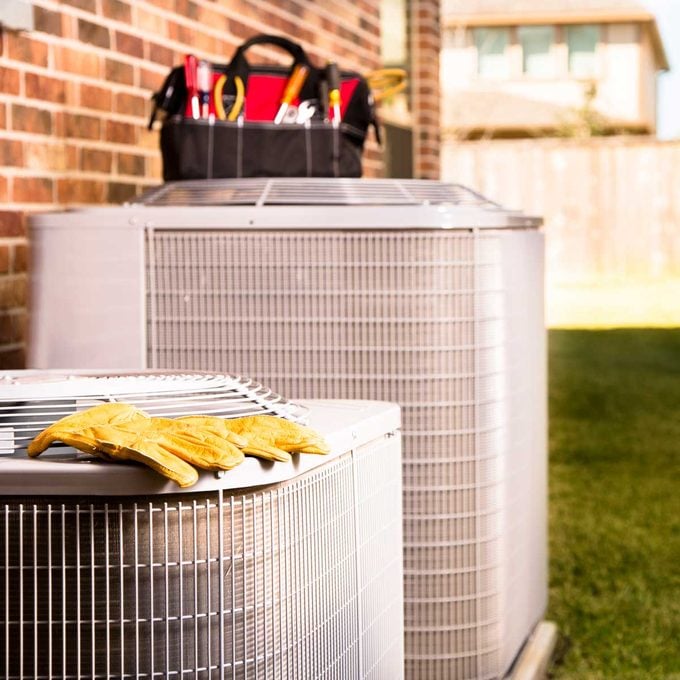Why Isn’t My Central Air Conditioner Blowing Cold Air?
Updated: May 24, 2023
Has your central AC stopped blowing cold air? Here are some simple troubleshooting steps to take before you make a repair call!

Has your central air conditioner suddenly stopped blowing cool air? Here are some simple steps to help you troubleshoot the problem if your central air conditioner isn’t cooling properly.
On This Page
Terminology
Before we begin, let’s have a quick refresher course on central air conditioning.
Air conditioners work by compressing a fluid refrigerant, causing it to move between two sets of metal coils. Air is drawn across the cold coils (the evaporator coils) and then blown back into the home through a series of ducts and dampers. The temperature is set at the thermostat, and the whole thing is regulated by the control board (often called the PCB, for printed circuit board).
For the purposes of this article, we’re assuming that you have a split-unit central air conditioner, meaning the evaporator coil is inside the house while the air conditioner condenser unit, coils and compressor are outside.
Power
When your central AC isn’t cooling, begin with the simplest troubleshooting steps. Verify that the AC is getting power by checking these three spots: the circuit breaker at the panel, the exterior unit’s disconnect and the furnace or heat pump’s power switch. That final item can sometimes get bumped accidentally, and the fix is as simple as flipping a switch.
Air Flow
In a central air conditioner, nothing causes more problems or is more easily repaired than air flow. The air flow is driven by a large fan (the “blower”) inside the home.
Check the furnace filter to see if it needs to be replaced. A dirty filter prevents air from crossing the evaporator coils, which means that all that cooling power sits inside the air conditioner and never gets spread throughout the house. It’s important to let your AC “breathe” by changing the filter regularly.
Ductwork Trunk Near Blower
If the fan is running and the filter is clean, feel the ductwork trunk just past the blower. If that trunk is cold, then there may be something obstructing the air flow further down the line. That means it’s time to troubleshoot the ducts.
Ductwork Dampers
Many homes have dampers in the ductwork. These allow you to force air to the parts of the home that need more, depending on season. If the dampers are out of alignment, often from being bumped or improperly set, they can act as roadblocks that prevent the cold air from getting to where it needs to be. Similarly, damaged or leaky ducts can allow cold air to escape, releasing it into the house before it gets to your living space.
Vents
Most rooms in your home also have adjustable vents. Check to be sure they aren’t covered or obstructed. You can also peek inside with a flashlight to see if the dust build-up is enough to warrant air duct cleaning.
Evaporator Coils
If you see excess water dripping off the AC cabinet, or ice forming around the refrigerant line, then your evaporator coils may be producing ice that interferes with the flow of air. This results in higher energy bills and poor cooling.
To troubleshoot this issue, turn off the AC for 24 hours and set the fan to On or Fan Only to run warm air over the coils. (The initial ice build-up is often caused by poor airflow, so change the filter as well!) If the ice reappears after you restart the system, you may have a refrigerant issue.
Condenser Coils
Central air conditioners move heat from the interior of your home to the outside. (If you stand next to the exterior unit while it’s running you’ll feel a blast of warm air. That’s heat from your home being set free.)
But if the condenser coils are obstructed by dirt, leaves or debris, the heat won’t escape effectively. This can cause your central AC to work intermittently, with short bursts of cooling, punctuated by lukewarm air coming from the vents. To fix it, start by cleaning the air conditioning condenser unit.
Capacitor
If the exterior unit isn’t kicking on at all, the capacitor may need to be replaced. This is a great DIY air conditioner repair, but only if you’re comfortable working with electronics. Remember that capacitors can hold a lethal charge!
Compressor and Refrigerant Issues
Unfortunately, more complex issues with the compressor and refrigerant are often more hassle than they’re worth for the DIYer. Air conditioning is a closed system, so you should never need to “top off” your refrigerant. If it’s low, it’s because there’s a leak. Until the leak is fixed, any refill is temporary.
If your refrigerant turns out to be low, check your system to see what kind of refrigerant it uses, and keep that in mind when getting estimates. If you have an older Freon-based system that is being phased out, it may be time for a central AC unit replacement.